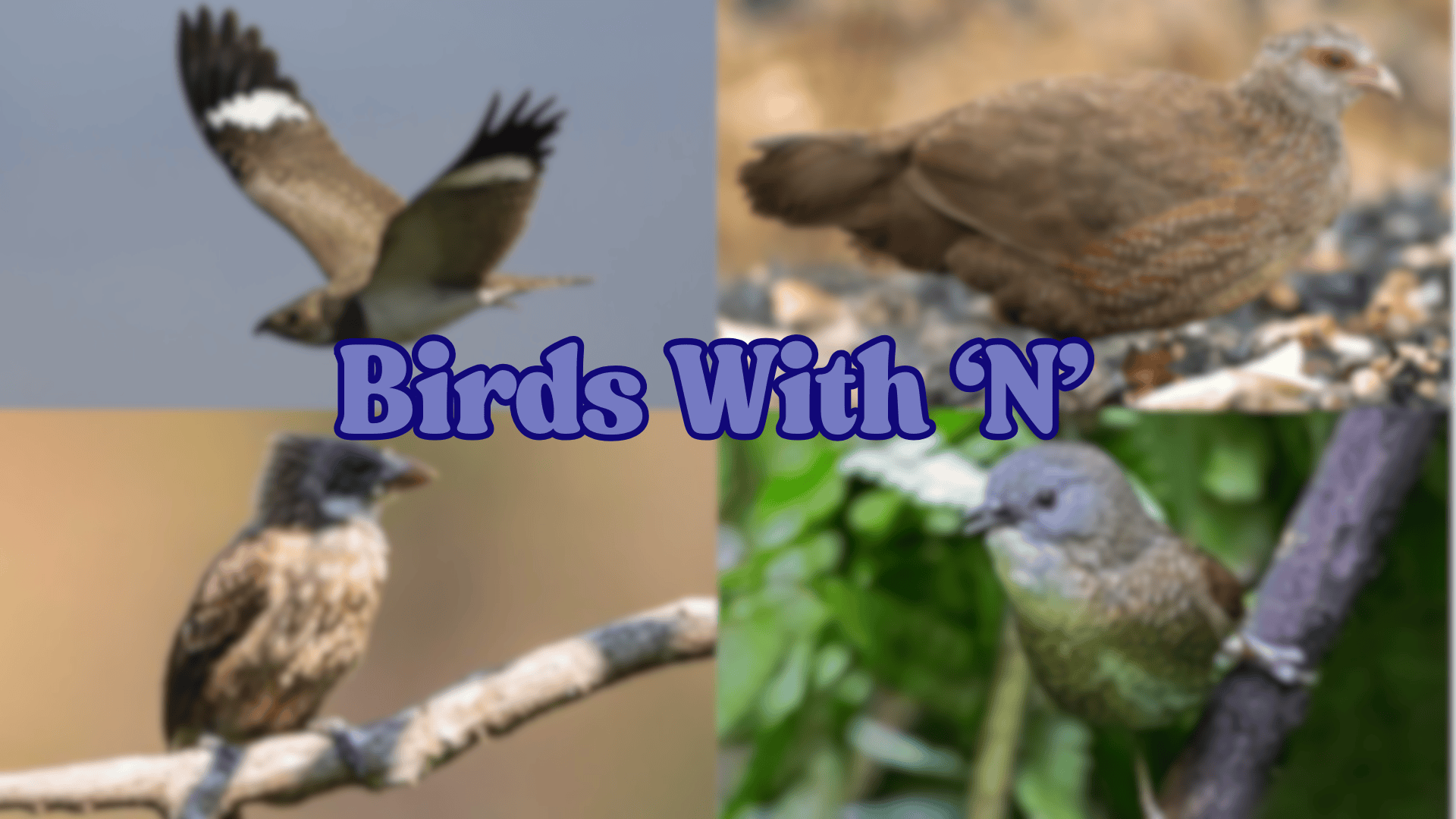
From dawn chorus to twilight calls, the world of birds beginning with “N” offers a symphony of diversity.
“Nature’s winged wonders” aptly describes these remarkable creatures that inhabit our skies, forests, wetlands, and urban spaces. This collection presents notable avian species arranged by their prevalence in the wild.
Each feathered ambassador carries its own distinctive story – whether through brilliant plumage, remarkable migration patterns, or exceptional vocal abilities.
The Northern Cardinal’s scarlet grace contrasts with the unassuming yet vocally gifted Nightingale, while the engineering expertise of Nuthatches defies gravity as they move headfirst down tree trunks.
Understanding these birds—their habitats, behaviors, and unique adaptations—will help you gain a deeper appreciation for the intricate balance of our natural world. Explore what makes each species truly exceptional and worth conserving.
The Hidden World of “N” Birds
1. Nacunda Nighthawk

The Nacunda Nighthawk is one of the largest nightjar species, with a wingspan of approximately 60-65 cm (24-26 inches).
It features cryptic plumage in mottled gray, brown, and white coloration that provides excellent camouflage during daylight hours when resting on the ground.
Notable features include its broad wings, short bill, and large gape, which are adapted for catching insects in flight.
- Region of Habitat: Found in central and eastern South America, primarily in Argentina, Bolivia, Brazil, Paraguay, and Uruguay. Prefers open grasslands, savannas, and occasionally marsh edges.
- Scientific Name: Chordeiles nacunda (sometimes classified as Podager nacunda)
- Feeding Habits: It is primarily insectivorous, feeding on flying insects such as beetles, moths, and flying ants, which it captures while in flight. It typically hunts at dusk and dawn, using its wide mouth to catch prey
- What Sound They Make: Makes a distinctive nasal “nyaow” or “kwaow” call, particularly during breeding season. Also produces a soft churrn sound during territorial displays.
Fun Facts
This nighthawk often feeds in groups, sometimes forming flocks of hundreds of birds when insects are abundant.
Unlike many nocturnal birds, the Nacunda Nighthawk is known to be active during daylight hours, especially on overcast days.
2. Naga Wren-babbler
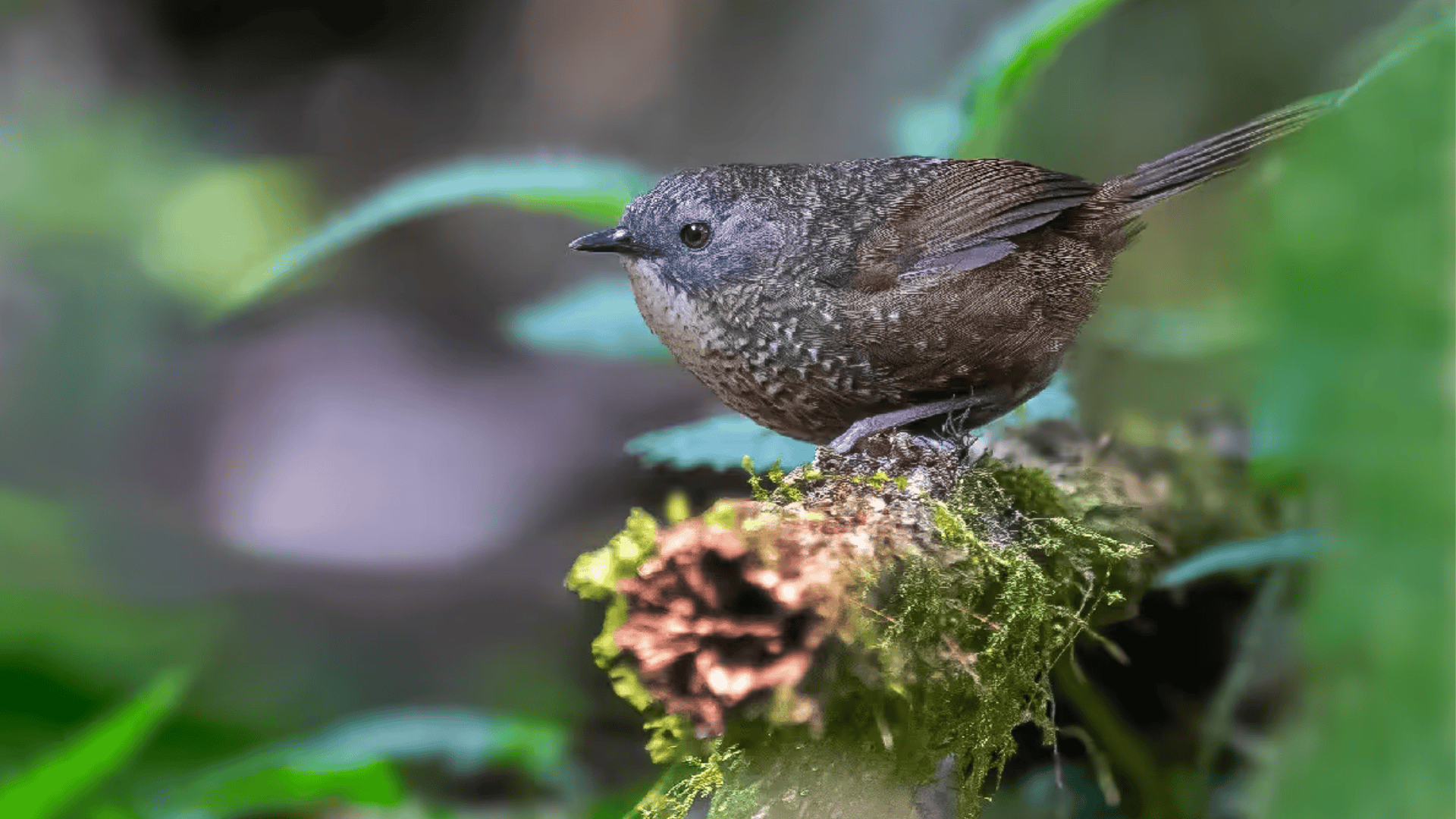
The Naga Wren-babbler is a small, secretive bird approximately 12-14 cm (4.7-5.5 inches) in length. It displays predominantly brown feathers with distinctive streaking on its throat and breast. It has a relatively short tail, rounded wings, and a slightly downward-curved bill that helps it forage in dense undergrowth.
- Region of Habitat: Endemic to the Naga Hills and adjacent areas along the India-Myanmar border in Northeast India. Prefers montane evergreen forests with dense undergrowth at elevations between 1,500-2,500 meters.
- Scientific Name: Spelaeornis chocolatinus
- Feeding Habits: Primarily insectivorous, foraging in dense undergrowth and leaf litter for small insects, larvae, and occasionally small seeds. Often seen hopping along the forest floor or in low vegetation.
- What Sound They Make: They produce a series of high-pitched, melodious warbling notes that rise and fall in pitch. Also makes soft, continuous chattering calls while foraging
Fun Facts
The Naga Wren-babbler was previously considered a subspecies of the Long-tailed Wren-babbler until genetic studies confirmed its status as a distinct species.
It is considered vulnerable due to its restricted range and ongoing habitat loss in the Eastern Himalayas region.
3. Nahan’s Partridge
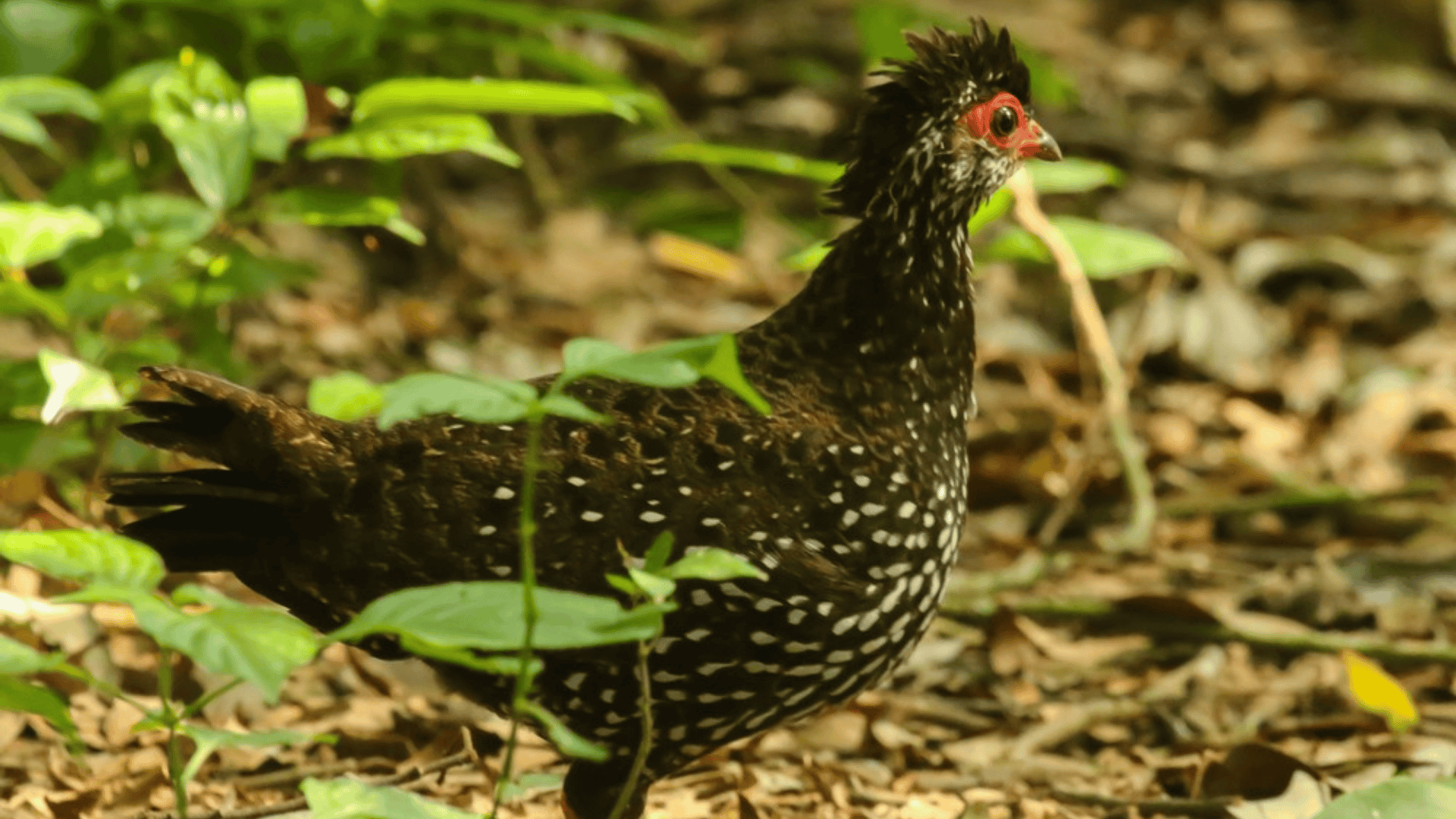
Nahan’s Partridge is a medium-sized ground-dwelling bird measuring about 25-28 cm (10-11 inches) in length. It has a distinctive reddish-brown back, gray breast, and black-and-white barred flanks.
The face features a noticeable pattern with a white throat, red orbital skin, and a short, curved bill.
- Region of Habitat: Endemic to the forests of eastern Uganda and western Kenya, specifically in the Kakamega Forest and surrounding areas. Prefers lowland primary rainforest with dense undergrowth.
- Scientific Name: Ptilopachus nahani
- Feeding Habits: Omnivorous, feeding primarily on insects, seeds, berries, and fallen fruits. Forages by scratching the forest floor leaf litter, typically in small family groups.
- What Sound They Make: Produces a distinctive series of loud, accelerating whistles that increase in tempo and end with a trill. Also makes soft clucking sounds when communicating within family groups.
Fun Facts
Despite being classified as a partridge, genetic studies have revealed that Nahan’s Partridge is more closely related to New World quails than to Old World partridges and pheasants.
It is an endangered species with a highly fragmented population due to extensive deforestation in its limited range.
4. Naked-faced Barbet
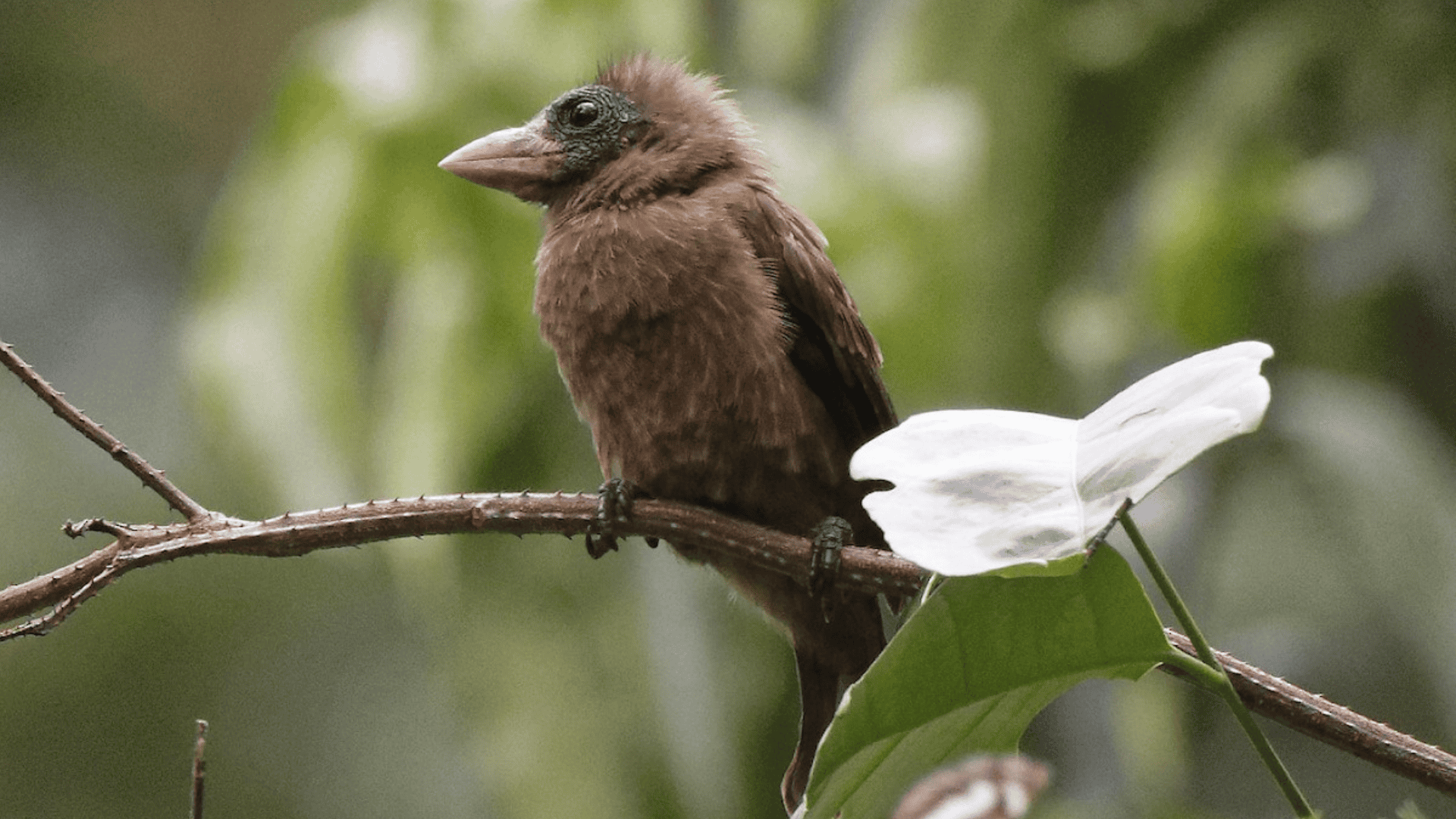
The Naked-faced Barbet is a distinctive medium-sized bird measuring approximately 20-23 cm (8-9 inches) in length.
As its name suggests, it has a conspicuous bare patch of facial skin that is bright red or pinkish. The plumage is primarily black with bright yellow highlights on the breast, throat, and head, creating a striking contrast.
- Region of Habitat: Found in western and central Africa, spanning countries including Cameroon, Gabon, Congo, and parts of Nigeria. Prefers lowland rainforests and secondary forests, occasionally venturing into forest edges and clearings.
- Scientific Name: Gymnobucco calvus
- Feeding Habits: Primarily frugivorous, feeding on a variety of fruits, particularly figs. Also consumes insects, especially during breeding season to provide protein for nestlings. Often forages in small groups or pairs.
- What Sound They Make: Produces various loud, harsh calls including a distinctive rapid chattering “kuk-kuk-kuk” and rasping notes. Colonies can be quite noisy with multiple birds calling together.
Fun Facts
Naked-faced Barbets are highly social and often nest in colonies, excavating multiple nest holes in dead trees that other bird species may use after abandonment.
The bare facial skin can change slightly in intensity of color depending on the bird’s emotional state and health.
5. Naked-faced Spiderhunter
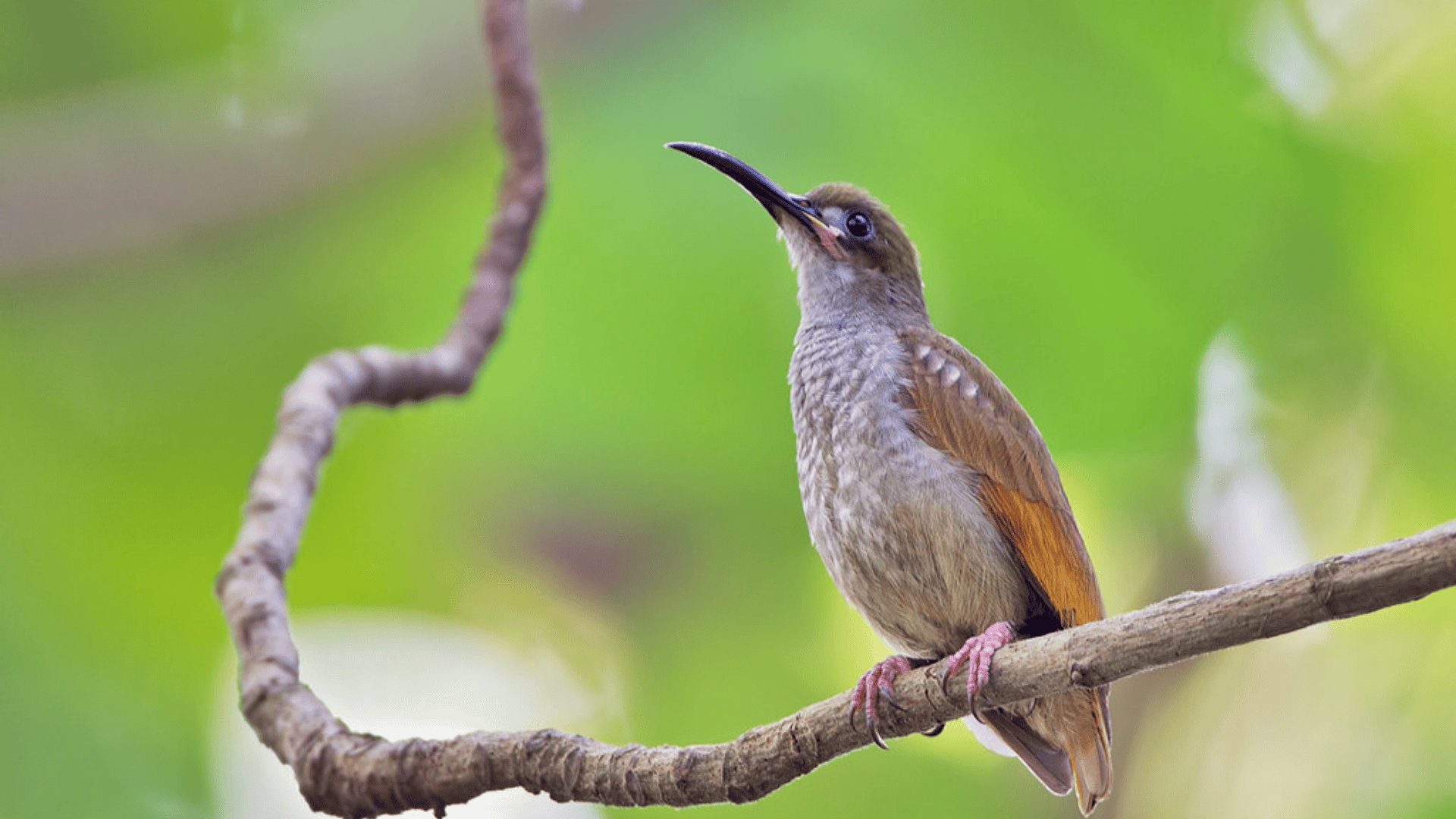
The Naked-faced Spiderhunter is a medium-sized sunbird relative, measuring about 18-20 cm (7-8 inches) in length.
It features a very long, curved bill adapted for nectar feeding, and as its name suggests, has a distinctive bare facial patch that appears bluish-gray. Its plumage is predominantly olive-green above and yellowish below.
- Region of Habitat: Native to Southeast Asia, found primarily in Malaysia, Indonesia (Sumatra, Java, Borneo), and Brunei. Inhabits lowland and montane forests, particularly in areas with flowering trees and bamboo groves.
- Scientific Name: Arachnothera clarae
- Feeding Habits: Primarily nectarivorous, feeding on nectar from various flowering plants using its specialized bill. Also consumes spiders, small insects, and occasionally fruits. Known to defend flowering trees within its territory.
- What Sound They Make: Produces sharp, high-pitched “tsip” or “chip” calls, often repeated in rapid succession. During breeding season, males perform a simple but melodious song consisting of descending whistles.
Fun Facts
Despite its name, the Naked-faced Spiderhunter doesn’t primarily hunt spiders—it was named for its occasional spider consumption.
It plays an important ecological role as a pollinator for many forest plants with tubular flowers that other birds cannot access due to their shorter bills.
6. Namaqua Dove
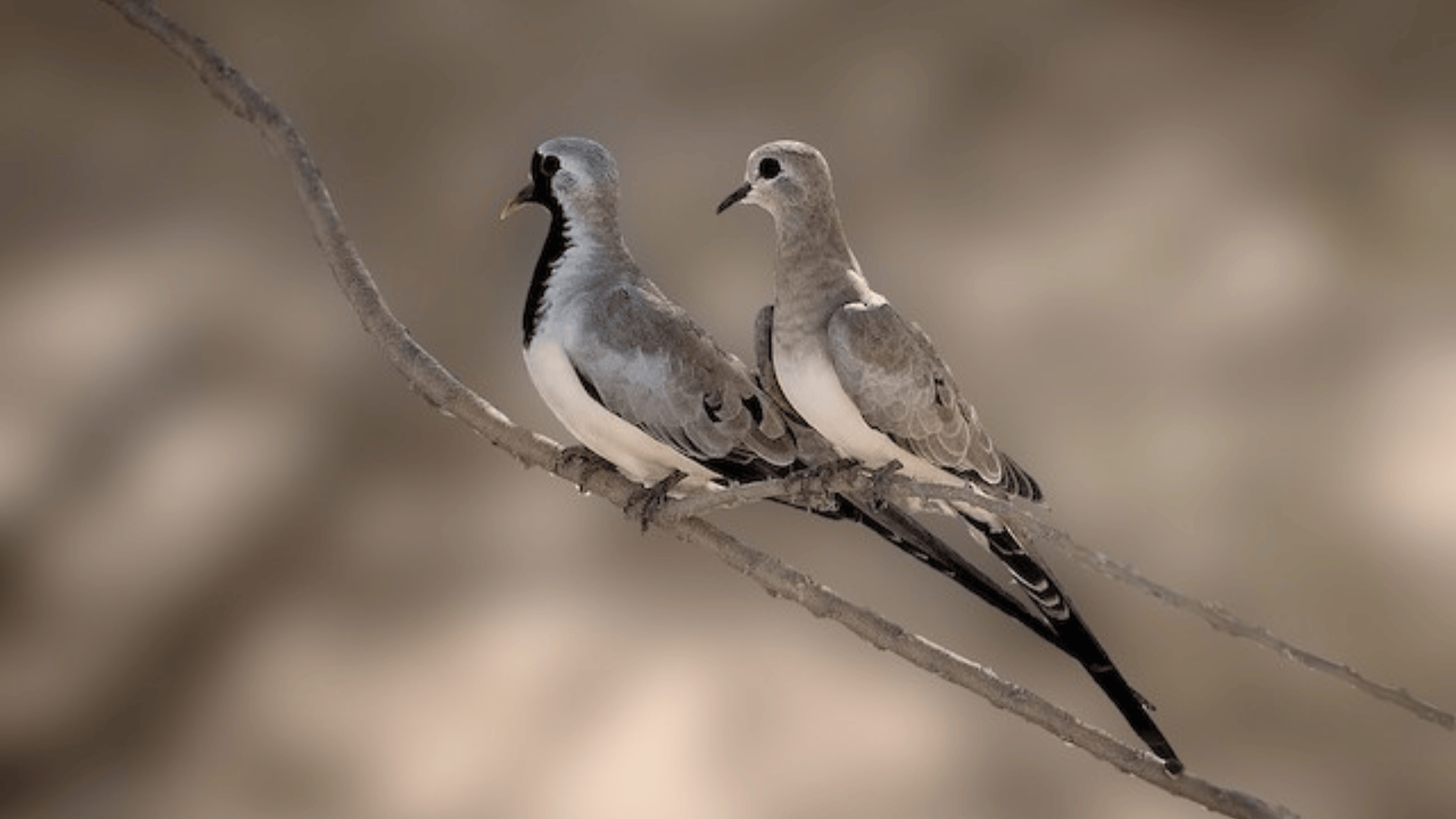
The Namaqua Dove is a small, slender dove measuring approximately 22-25 cm (8.5-10 inches) in length, including its long tail.
Males have distinctive black throats and faces contrasting with gray bodies, while females are more uniformly light brown. Both sexes have long tails with white outer feathers that are visible in flight.
- Region of Habitat: Widespread across sub-Saharan Africa and parts of the Middle East, particularly in arid and semi-arid regions. Common in the Namib Desert, Kalahari, and similar dry environments with scattered vegetation.
- Scientific Name: Oena capensis
- Feeding Habits: Primarily granivorous, feeding on a variety of small seeds gathered from the ground. Often forages in pairs or small groups, walking along the ground in search of fallen seeds. Can survive with minimal water intake.
- What Sound They Make: Produces a soft, rhythmic cooing call that sounds like “coo-coo-coo” with the middle note higher in pitch. Males call more frequently from raised perches during breeding season.
Fun Facts
The Namaqua Dove is extraordinarily adapted to desert conditions and can survive in areas receiving less than 100mm of rainfall annually.
Its specialized kidneys allow it to excrete highly concentrated urine, minimizing water loss—a vital adaptation for desert survival.
7. Namaqua Sandgrouse
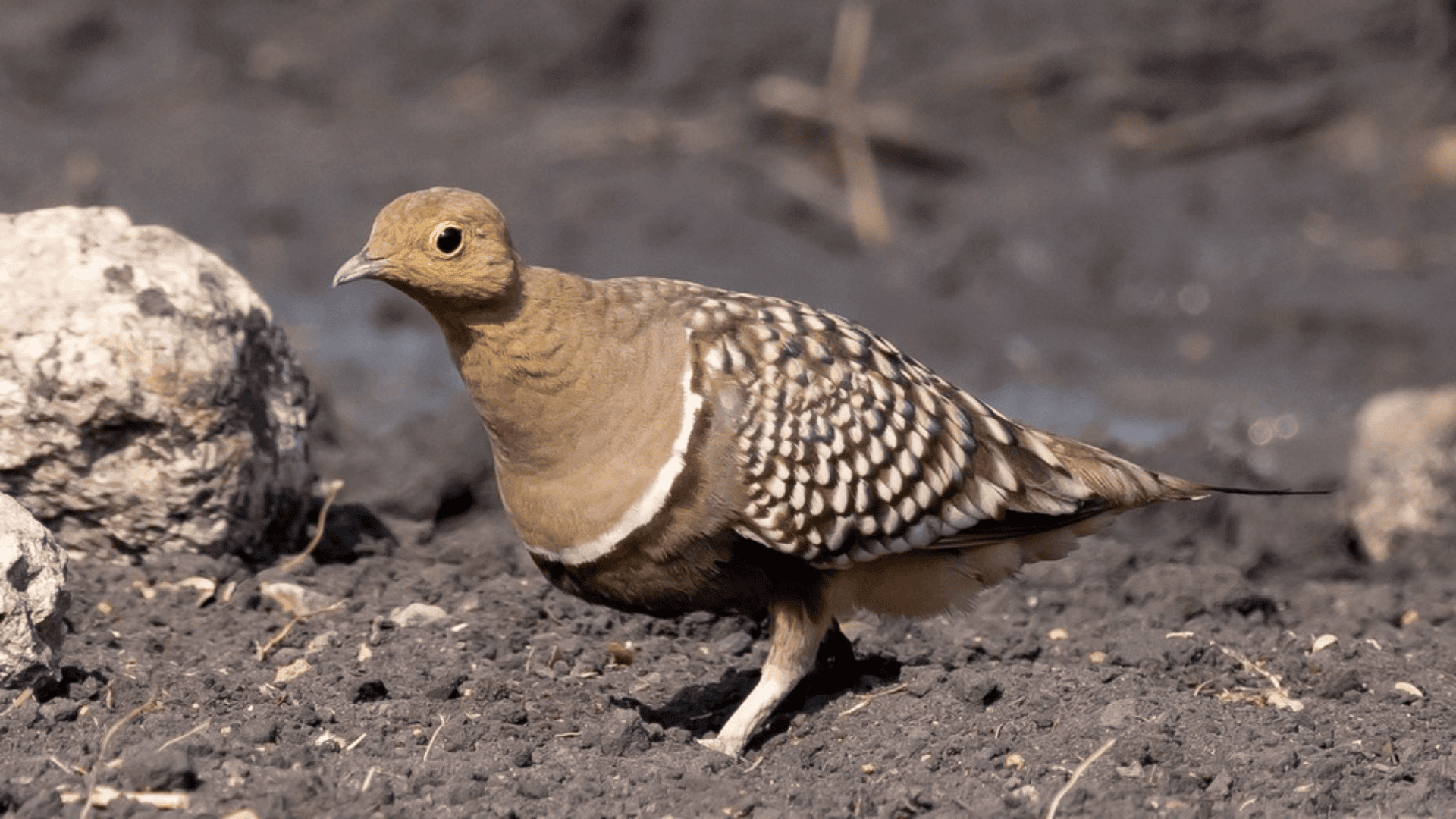
The Namaqua Sandgrouse is a medium-sized ground-dwelling bird measuring about 28-30 cm (11-12 inches) in length.
Males display distinctive plumage with black bellies, golden-buff upperparts, and a black throat framed by white markings.
Females are more cryptically colored, with mottled brown plumage. Both sexes have short legs and pointed wings adapted for desert living.
- Region of Habitat: Found across southern Africa, particularly in Namibia, Botswana, and South Africa. Prefers arid and semi-arid environments, including desert plains, dry scrubland, and sparsely vegetated grasslands.
- Scientific Name: Pterocles namaqua
- Feeding Habits: Primarily granivorous, feeding on various seeds of desert plants. Forages on the ground, often in flocks, gathering seeds during early morning and late afternoon to avoid midday heat.
- What Sound They Make: They produce a distinctive nasal “kelkiewyn” or “quip quip” call, particularly during flight. Also makes soft, purring sounds when in groups on the ground.
Fun Facts
Male Namaqua Sandgrouse have specialized belly feathers that can absorb and hold water like a sponge.
After visiting waterholes, males will fly back to their chicks—sometimes over distances of 30 kilometers—and the chicks will drink the water by sucking it from the male’s specially adapted feathers.
This remarkable adaptation allows them to breed in extremely arid environments far from water sources.
8. Namaqua Warbler

The Namaqua Warbler is a small, slender bird measuring about 12-14 cm (4.7-5.5 inches) in length.
It has predominantly grayish-brown upperparts with lighter underparts, a distinctive dark eye stripe, and a pale supercilium (eyebrow). Its long, slightly curved bill is adapted for probing in vegetation for insects.
- Region of Habitat: Native to southern Africa, particularly in Namibia, South Africa, and Botswana. Prefers dry river beds, riparian thickets, and arid scrubland with dense vegetation along seasonal watercourses.
- Scientific Name: Phragmacia substriata (formerly Calamonastes fasciolatus)
- Feeding Habits: Primarily insectivorous, feeding on a variety of small insects, spiders, and other arthropods. Forages by gleaning prey from branches, leaves, and bark, often probing with its bill into crevices.
- What Sound They Make: They produce a distinctive, repetitive “chip-chip-chip” call and a more melodious warbling song consisting of clear, whistled notes that rise and fall in pitch.
Fun Facts
Despite inhabiting arid regions, the Namaqua Warbler is almost always found close to at least seasonal water sources.
It builds a distinctive nest shaped like a small cup or pouch, typically woven into thorny bushes for protection from predators, and lines it with soft plant material, animal hair, and spider webs.
9. Namuli Apalis
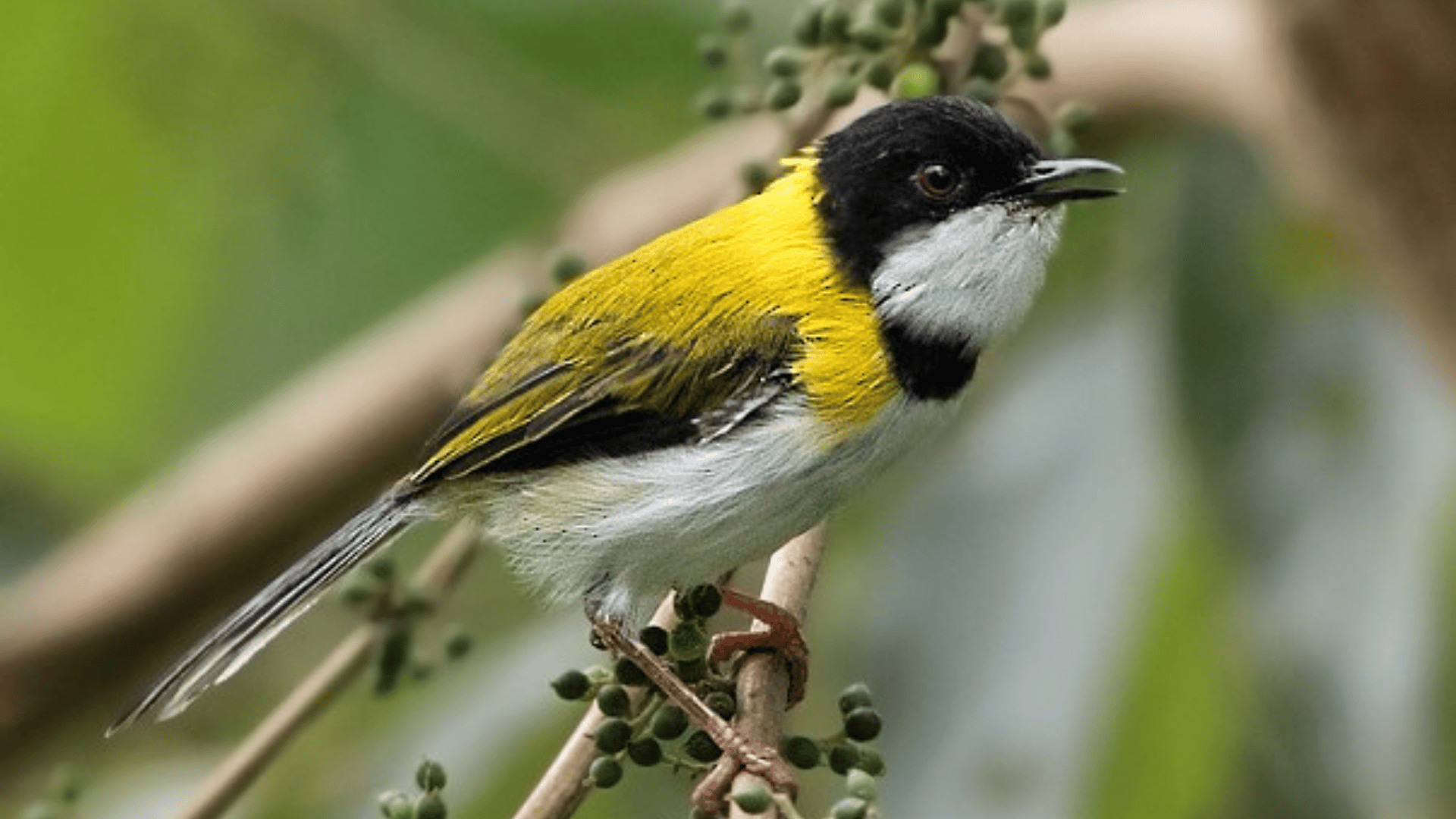
The Namuli Apalis is a tiny, active warbler measuring about 10-11 cm (4 inches) in length. It features distinctive olive-green upperparts, whitish underparts with light yellow on the flanks, and a relatively long, graduated tail that it often holds cocked upward. The head shows a distinctive gray crown and whitish throat.
- Region of Habitat: Endemic to a very small area in northern Mozambique, specifically Mount Namuli and nearby mountains. Prefers montane forests and forest edges at elevations between 1,200-1,900 meters.
- Scientific Name: Apalis lynesi
- Feeding Habits: Primarily insectivorous, feeding on small insects, caterpillars, and spiders. Forages actively in the mid to upper canopy, gleaning prey from leaves and branches while moving acrobatically through foliage.
- What Sound They Make: They produce a series of high-pitched, trilling notes that rise and fall in pitch. Also makes soft contact calls when foraging in pairs or small family groups.
Fun Facts
The Namuli Apalis was only scientifically described in 1932 and remains one of Africa’s least-known bird species due to its extremely restricted range and remote habitat.
It is considered endangered, with an estimated population of fewer than 1,000 individuals, making it one of the rarest birds in Africa.
10. Nanday Parakeet

The Nanday Parakeet is a medium-sized parrot measuring about 28-30 cm (11-12 inches) in length. It has a distinctive appearance with primarily green plumage, a black face and beak, blue-tinted wing feathers, and a long tail.
It also features reddish-brown thighs that contrast with its green body.
- Region of Habitat: Native to south-central South America, particularly Paraguay, southern Brazil, northern Argentina, and parts of Bolivia. Prefers open woodland, palm groves, savanna, and increasingly, urban areas. Has established feral populations in parts of the United States, particularly Florida and California.
- Scientific Name: Aratinga nenday
- Feeding Habits: Primarily herbivorous, feeding on a variety of seeds, fruits, nuts, berries, and blossoms. Often forages in flocks, both in trees and on the ground, and sometimes visits agricultural areas to feed on crops.
- What Sound They Make: They produce loud, harsh, screeching calls, particularly while in flight or when alarmed. These calls often sound like “kay-kay-kay” or “naahn-day” (which gave rise to its name). Also makes softer chattering sounds when socializing in groups.
Fun Facts
While considered a pest in some agricultural areas of its native range, the Nanday Parakeet has become a victim of its popularity as a pet.
Due to extensive trapping for the pet trade, its populations have declined in parts of its natural range. Interestingly, feral populations in the United States are primarily composed of escaped or released pets and their descendants.
11. Nankeen Kestrel
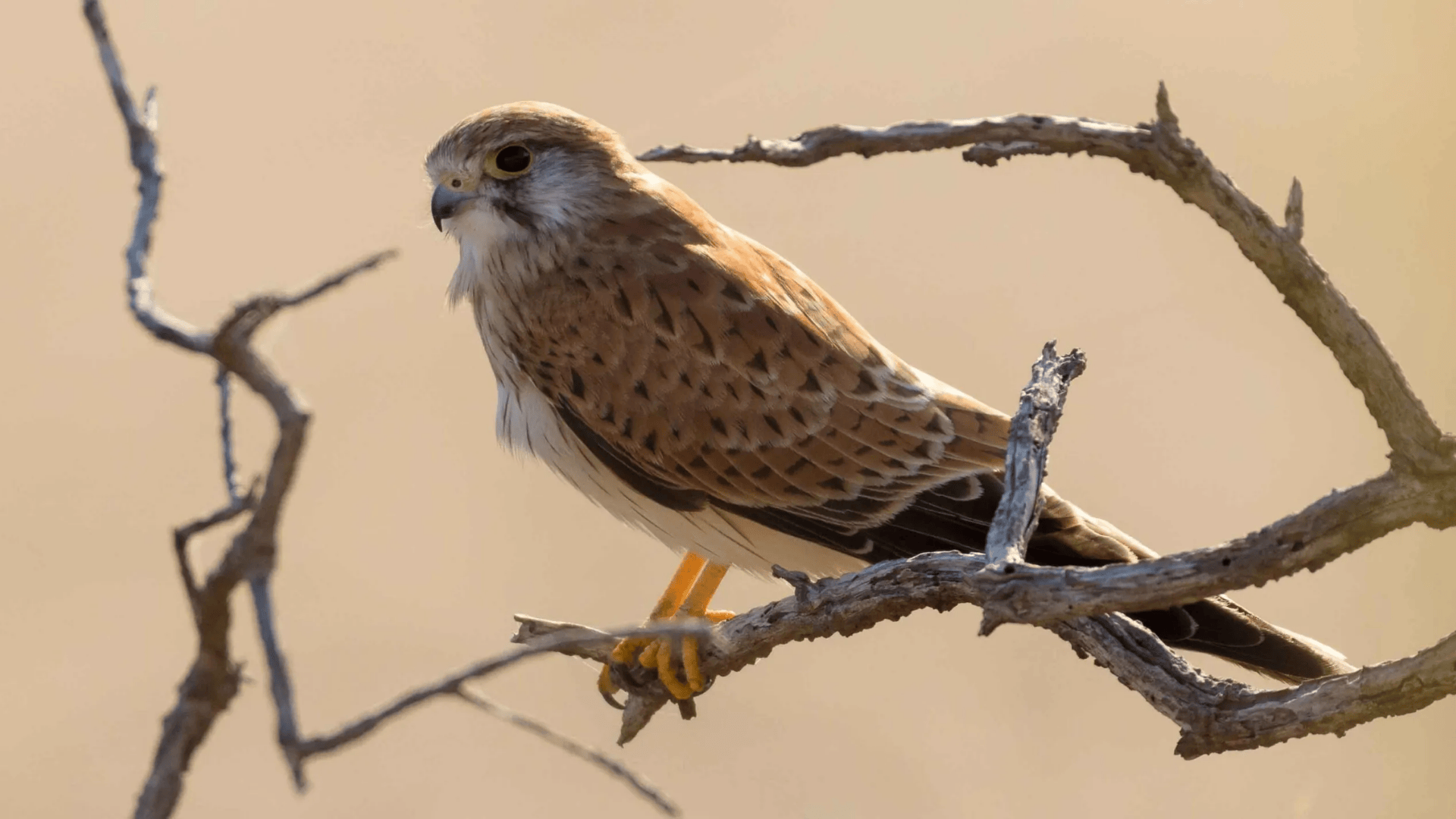
The Nankeen Kestrel is a small raptor measuring about 30-35 cm (12-14 inches) in length with a wingspan of 70-80 cm (28-31 inches).
It displays rufous-brown (nankeen-colored) upperparts, pale underparts with black streaking, and a distinctive black-tipped tail. Males have gray heads, while females have rufous heads with streaking.
- Region of Habitat: Native to Australia and parts of New Guinea and Indonesia. Found across nearly all of Australia in a wide variety of habitats, including open woodlands, grasslands, agricultural areas, deserts, and urban environments.
- Scientific Name: Falco cenchroides
- Feeding Habits: Primarily carnivorous, feeding mainly on small mammals (especially mice), lizards, small birds, and large insects. Hunts by hovering in mid-air with rapid wing beats before diving down to capture prey with its talons.
- What Sound They Make: Produces a shrill, repeated “kee-kee-kee” call, particularly during breeding season or when alarmed. Also makes softer chittering sounds during courtship or when communicating with mates.
Fun Facts
The Nankeen Kestrel is one of the few bird species that benefited from European settlement in Australia, as land clearing created more suitable hunting habitats.
During Australia’s mouse plagues, a single Nankeen Kestrel family can consume over 1,000 mice during a breeding season, making them valuable allies for farmers.
12. Nankeen Night Heron
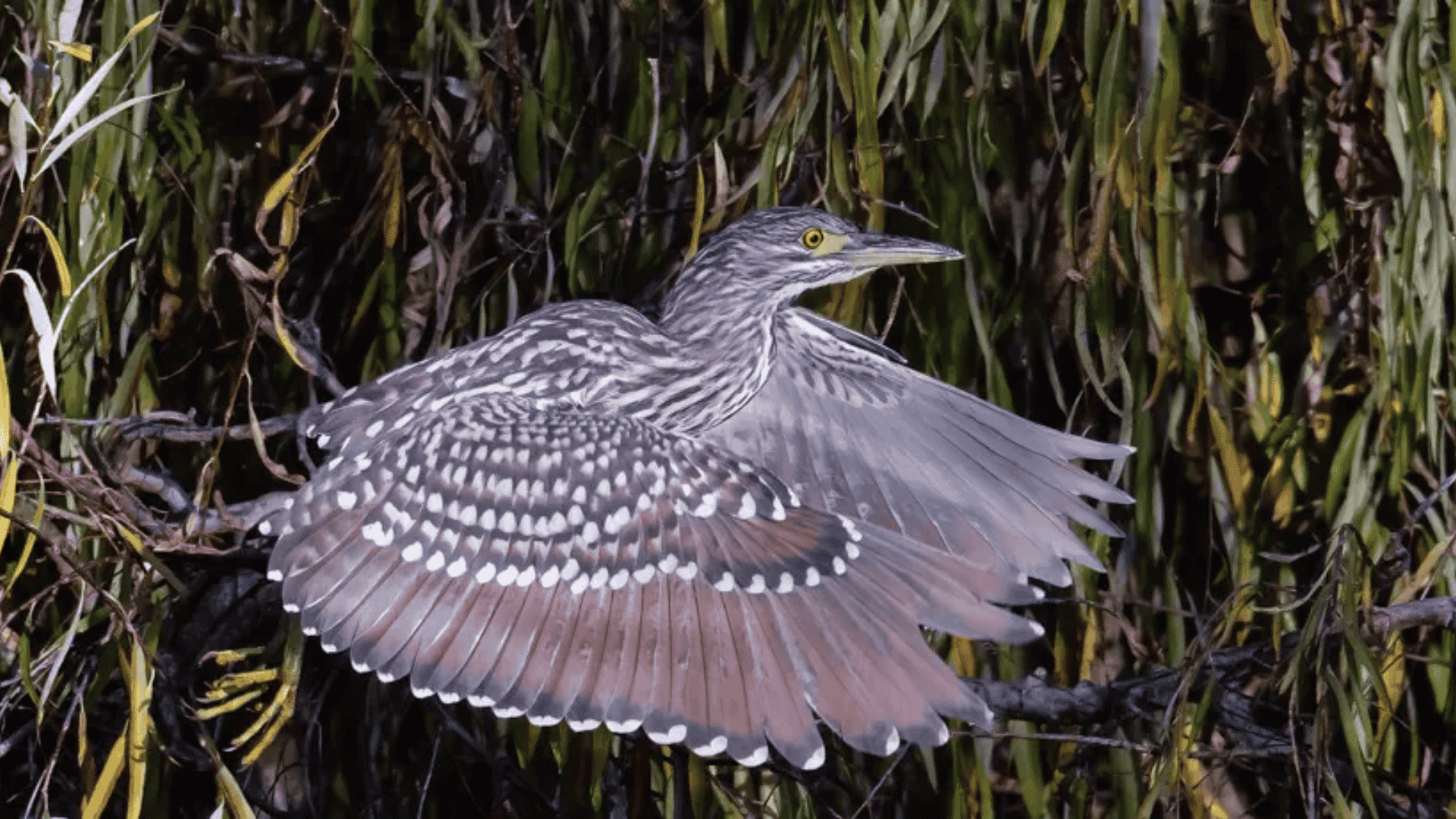
The Nankeen Night Heron is a medium-sized wading bird measuring about 55-65 cm (22-26 inches) in length.
Adults have distinctive cinnamon-rufous (nankeen-colored) plumage on their back and wings, with a black crown and white underparts.
They feature a stout bill, relatively short legs for a heron, and several long white plumes extending from the back of the head during breeding season.
- Region of Habitat: Found across much of Australia, parts of New Zealand, and throughout Southeast Asia to Japan. Prefers wetland environments, including marshes, mangroves, river edges, and artificial waterbodies such as reservoirs and rice fields.
- Scientific Name: Nycticorax caledonicus
- Feeding Habits: Primarily piscivorous, feeding on fish, frogs, crustaceans, aquatic insects, and occasionally small mammals and birds. Primarily nocturnal, it hunts by standing motionless at the water’s edge and striking rapidly when prey comes within range.
- What Sound They Make: They produce a distinctive, harsh “quawk” or “wok” call, typically heard at dusk as birds leave their daytime roosts. Juveniles make a more persistent begging call described as a croaking “krrr-krrr-krrr.”
Fun Facts
Despite being called “night” herons, they are not strictly nocturnal and can sometimes be observed feeding during daylight hours, especially when providing for hungry nestlings.
Unlike many other herons that nest solitarily, Nankeen Night Herons often form loose colonies, sometimes with hundreds of pairs nesting in close proximity in suitable habitat.
13. Napo Sabrewing
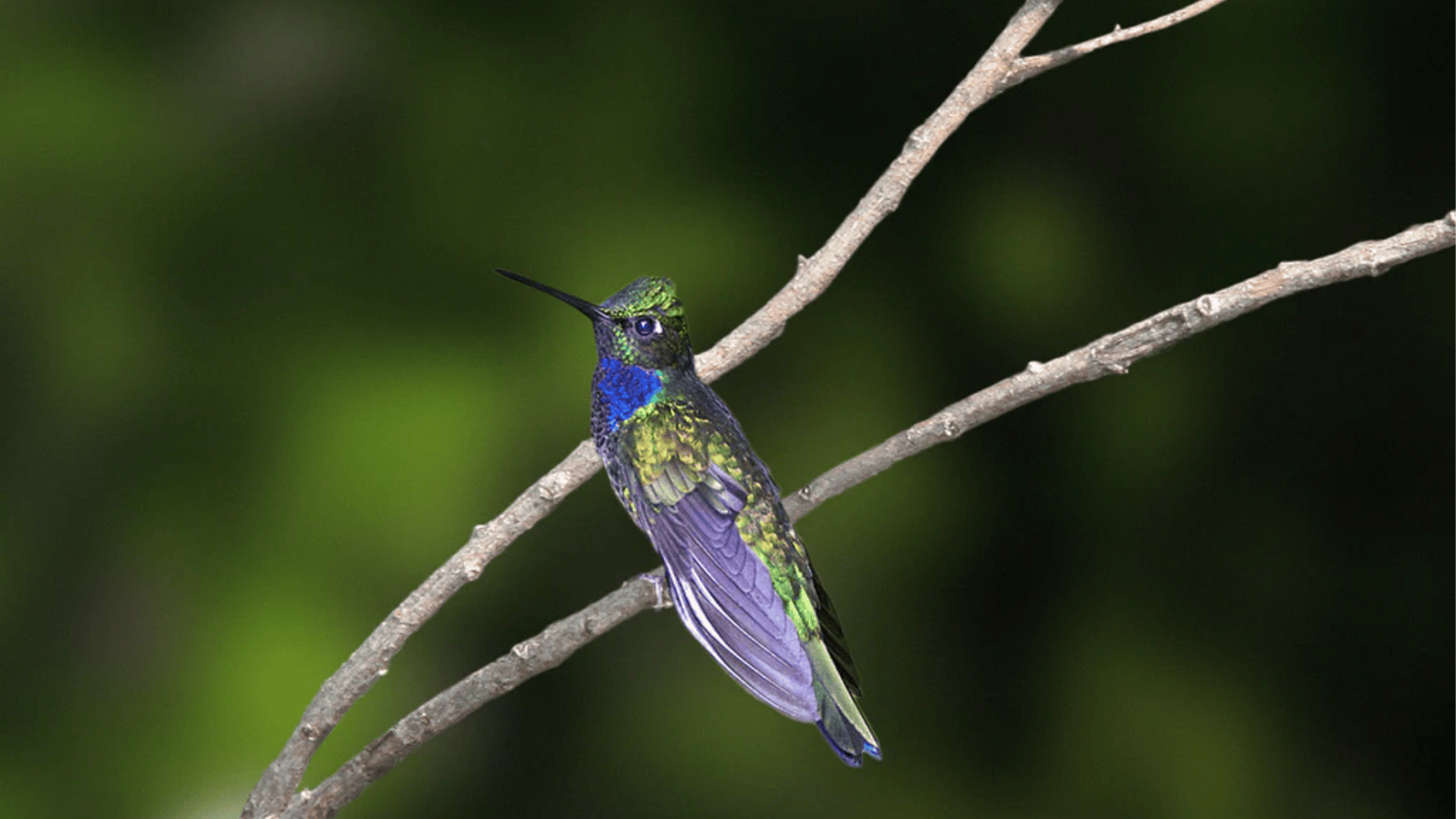
The Napo Sabrewing is a medium-sized hummingbird measuring about 12-13 cm (4.7-5.1 inches) in length. Males display metallic green upperparts, a distinctive white chest band, and a slightly forked tail.
They feature a long, slightly curved bill adapted for feeding from tubular flowers. The wings produce a distinctive sound in flight due to their shape.
- Region of Habitat: Native to the eastern foothills of the Andes in Ecuador and Peru, specifically in the upper Amazon basin along the Napo River watershed. Prefers humid montane forests and forest edges at elevations between 800-1,500 meters.
- Scientific Name: Campylopterus villaviscensio
- Feeding Habits: Primarily nectarivorous, feeding on nectar from a variety of flowering plants, particularly those with tubular blossoms. Also consumes small insects and spiders for protein. Defends feeding territories with aggressive aerial displays.
- What Sound They Make: Produces high-pitched chirps and twitters, particularly during territorial disputes. Males make a distinctive humming sound with their wings during display flights, created by specially modified primary wing feathers.
Fun Facts
The Napo Sabrewing gets its name from its specially adapted wing structure—the outer primary feathers of males are thickened and flattened like small sabers, creating distinctive sounds during flight and courtship displays.
It’s considered a bio-indicator species for healthy montane forest ecosystems in the upper Amazon basin.
14. Narcissus Flycatcher
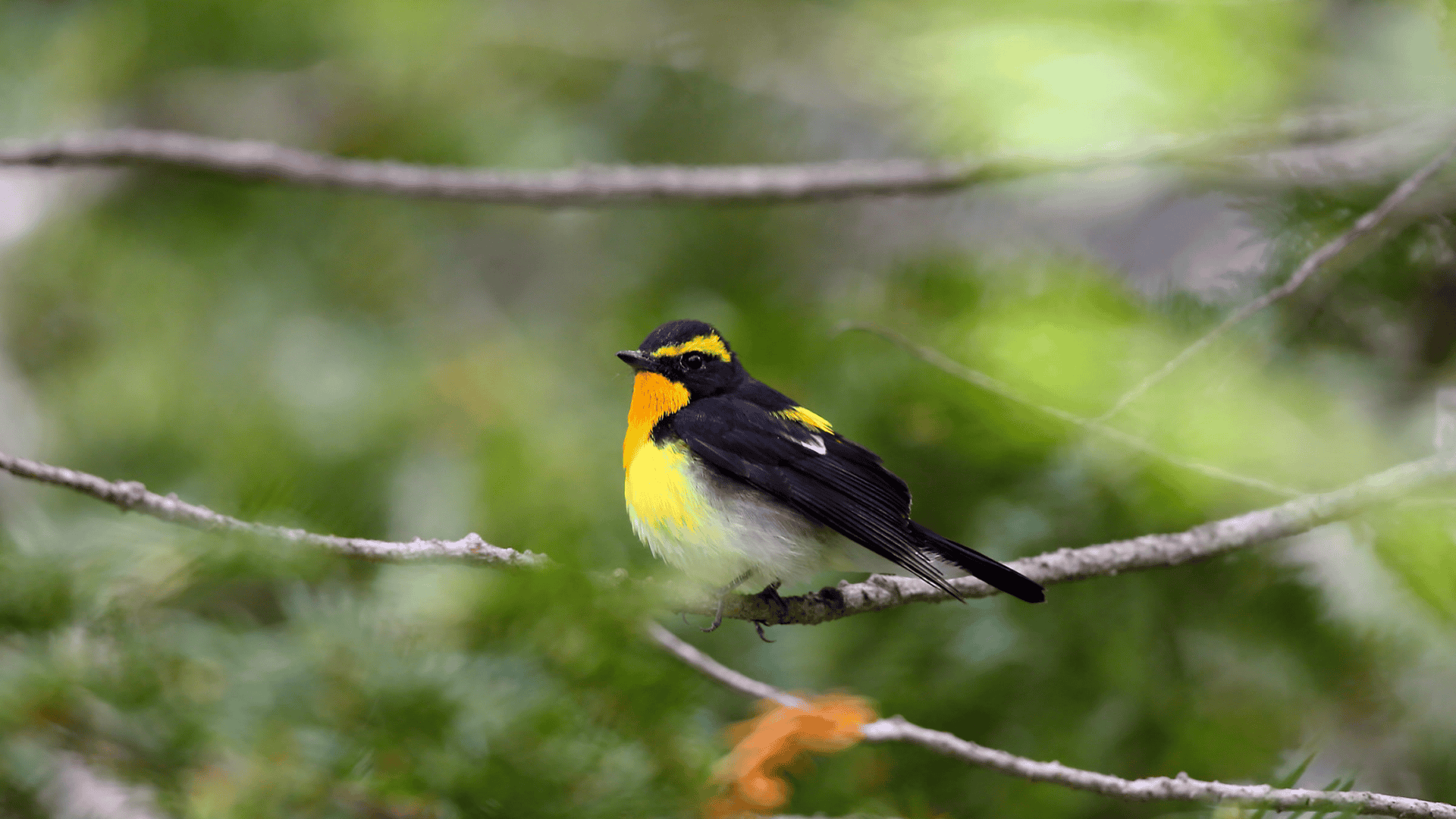
The Narcissus Flycatcher is a small, vibrantly colored passerine measuring about 13-15 cm (5-6 inches) in length.
Male birds display striking plumage with bright orange-yellow underparts, glossy blue-black upperparts, and a distinctive white patch on the wings. Females are more subtly colored, with olive-brown upper parts and pale yellowish underparts.
- Region of Habitat: Breeds in East Asia, including Japan, Korea, eastern China, and parts of Russia. Winters in Southeast Asia, particularly the Philippines, Malaysia, and Indonesia. Prefers deciduous and mixed forests with dense understories.
- Scientific Name: Ficedula narcissina
- Feeding Habits: Primarily insectivorous, feeding on flying insects such as flies, moths, and beetles. Employs a “sit-and-wait” hunting strategy, perching on branches before making short flights to catch insects in mid-air, then returning to the same or a nearby perch.
- What Sound They Make: They produce a distinctive, high-pitched “tszee-tszee” call and a more complex song consisting of varied whistling notes. Males are particularly vocal during breeding season when establishing territories.
Fun Facts
The Narcissus Flycatcher is named after the bright yellow narcissus flower due to its vibrant coloration. It’s a long-distance migrant, with some individuals traveling over 3,000 kilometers between breeding and wintering grounds.
Recent genetic studies have shown that birds previously considered subspecies are actually distinct species, leading to taxonomic revisions within this group.
15. Narcondam Hornbill
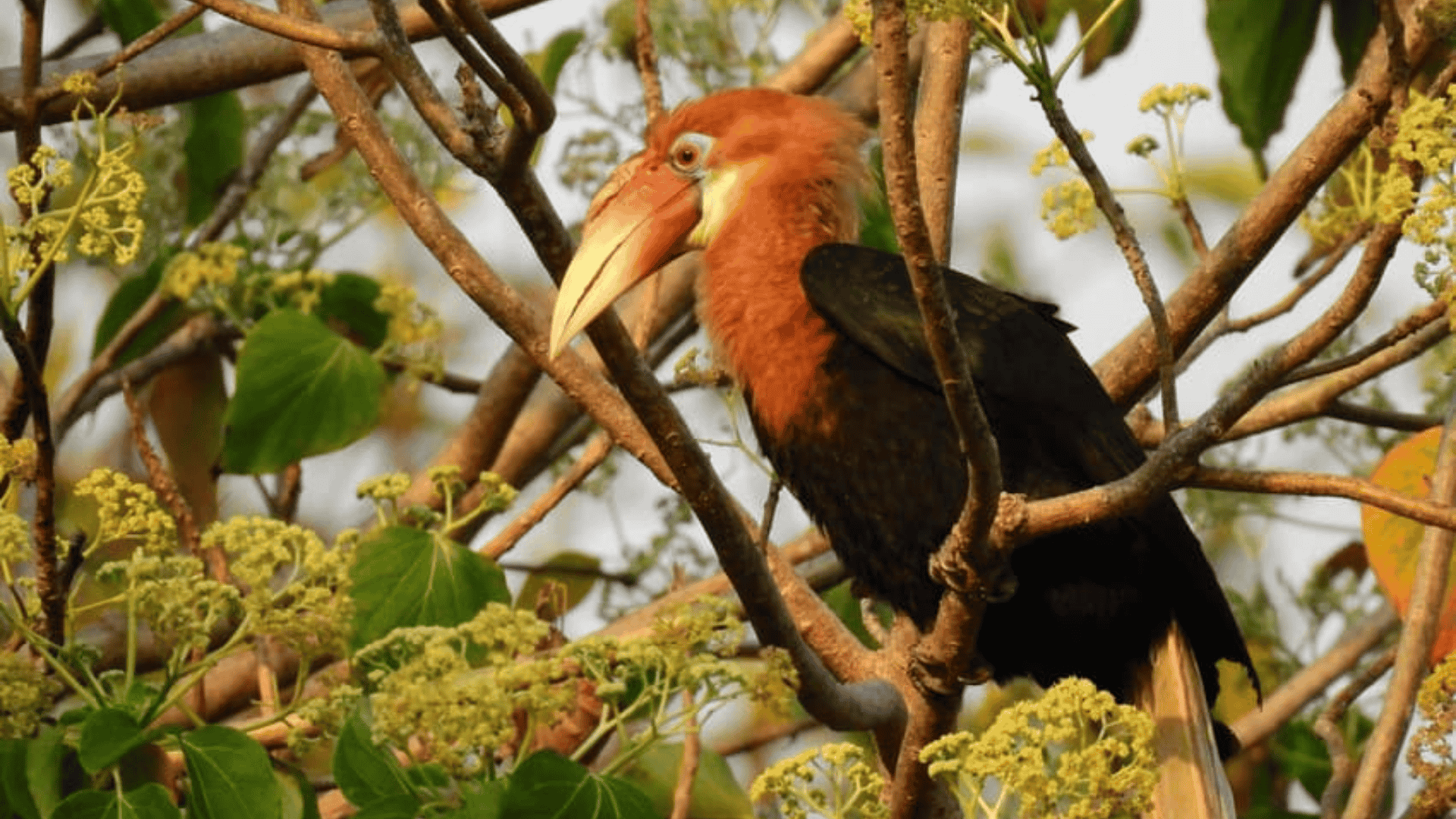
The Narcondam Hornbill is a medium-sized hornbill measuring about 45-50 cm (18-20 inches) in length. It features predominantly black plumage with a yellowish-white bill and casque (the horn-like structure on top of the bill).
Males have rufous-colored heads and necks, while females are entirely black with a blue throat patch. The tail shows distinctive white tips visible in flight.
- Region of Habitat: Endemic solely to Narcondam Island, a tiny volcanic island (6.8 km²) in the Andaman Sea, India. Restricted to the tropical forest habitat on this small island, occurring from sea level up to the island’s highest point at approximately 700 meters.
- Scientific Name: Rhyticeros narcondami
- Feeding Habits: Primarily frugivorous, feeding mainly on wild figs and other forest fruits. Also consumes insects, small reptiles, and nestlings of other birds when available. Forages in the canopy, using its large bill to pluck fruits directly from branches.
- What Sound They Make: They produce loud, barking calls that can be heard throughout the forest, described as a repeated “kak-kak-kak” sound. They also make hollow, booming calls that resonate through the forest during territorial displays.
Fun Facts
The Narcondam Hornbill has one of the most restricted ranges of any bird in the world, being found only on a single island of less than 7 square kilometers.
With an estimated population of just 200-300 individuals, it’s considered vulnerable to extinction. The species has evolved in isolation for thousands of years, developing distinct characteristics from its mainland relatives.
16. Naretha Bluebonnet
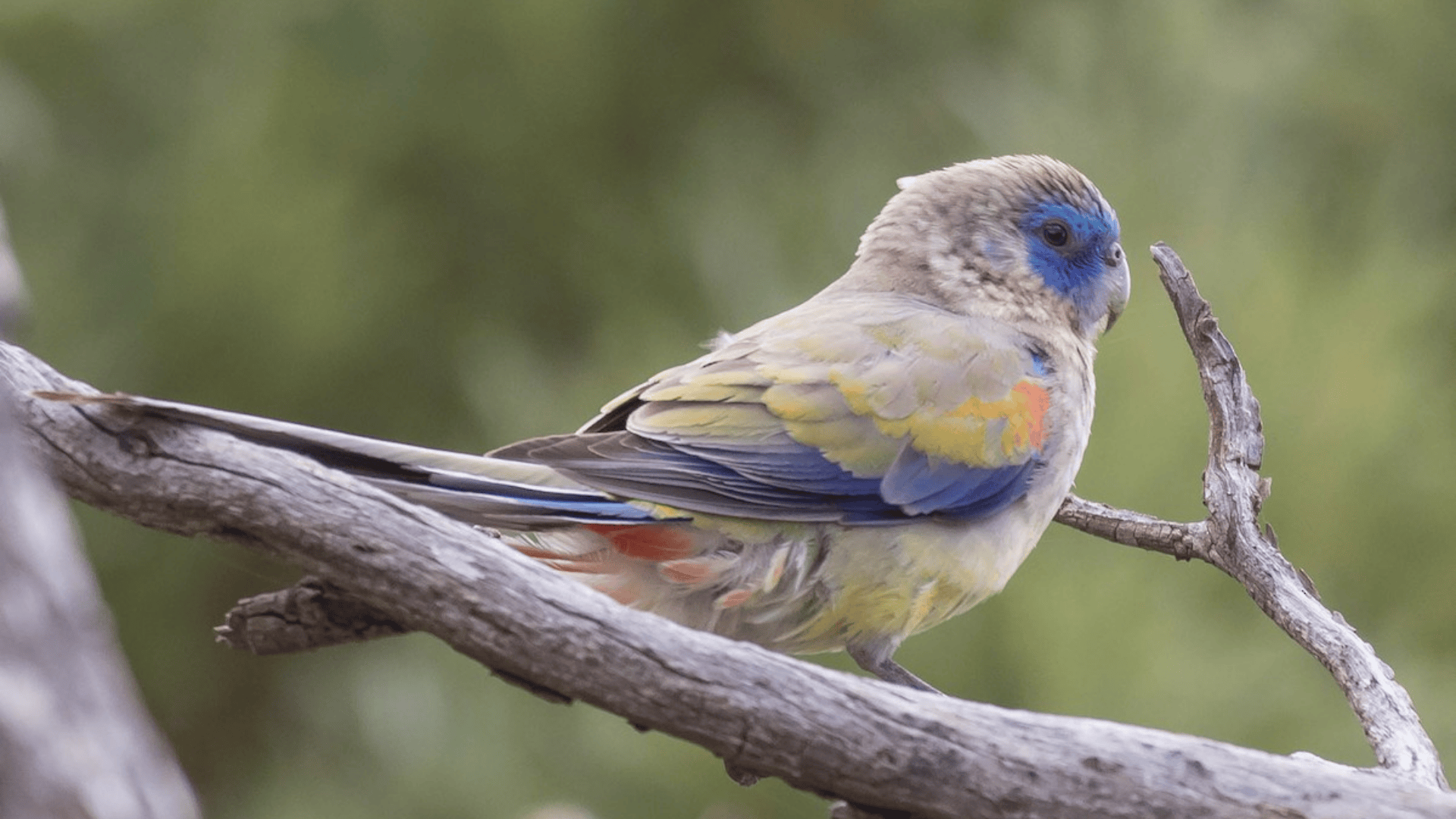
The Naretha Bluebonnet is a medium-sized parrot measuring about 30-33 cm (12-13 inches) in length. It displays distinctive plumage with a blue-gray head, brownish back, blue wings, and a pale yellowish underside.
It features a small crest that can be raised when excited and a pale bill. Both sexes look similar, though males are slightly larger with brighter coloration.
- Region of Habitat: Endemic to a small area of southern Australia, specifically the western Nullarbor Plain across the border region of Western Australia and South Australia. Prefers arid and semi-arid woodlands dominated by eucalyptus and mulga trees.
- Scientific Name: Northiella narethae
- Feeding Habits: Primarily granivorous, feeding on seeds from native grasses and shrubs. Also consume berries, fruits, flowers, and occasionally insects and their larvae. Forages mainly on the ground but also feeds in trees and shrubs.
- What Sound They Make: They produce soft, musical chattering calls and whistles. Flight calls include a distinctive “tsit-tsit” sound. Also makes quiet murmuring sounds when feeding in small groups.
Fun Facts
The Naretha Bluebonnet was only recognized as a distinct species in 1991, having previously been considered a subspecies of the Bluebonnet parrot.
It’s specially adapted to survive in one of Australia’s harshest environments, the Nullarbor Plain, which experiences extreme temperature fluctuations and limited water availability.
This parrot can survive without drinking for extended periods by deriving moisture from its food.
17. Narina Trogon
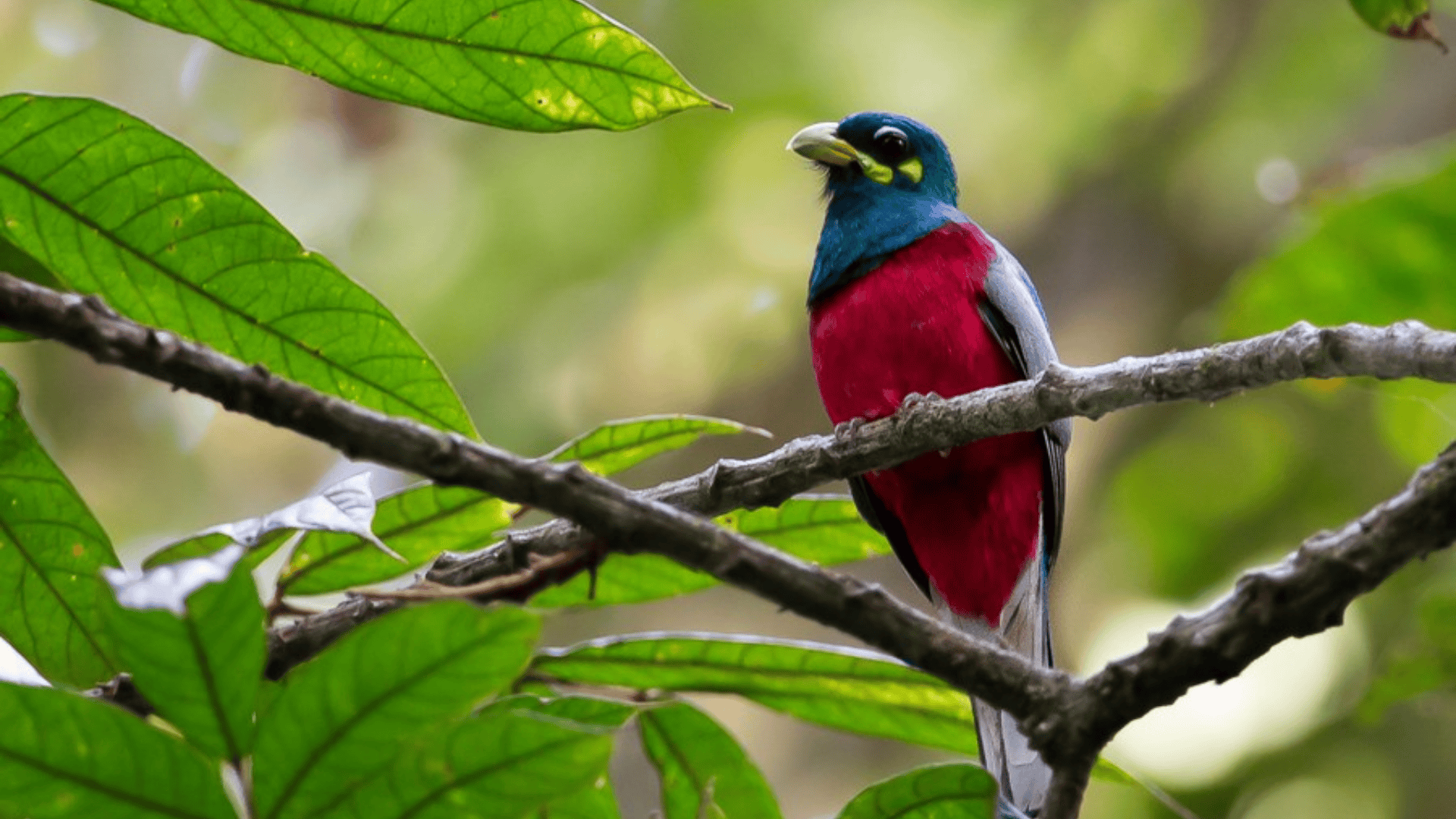
The Narina Trogon is a strikingly beautiful bird measuring about 30-34 cm (12-13 inches) in length, including its long tail. Males display brilliant metallic green upperparts and head, with a vivid crimson-red breast and underparts.
Females are less vibrant, with brownish-gray upper parts and heads and reddish-brown under parts. Both sexes have distinctive squared-off tails and small, curved bills.
- Region of Habitat: Widely distributed across sub-Saharan Africa, from Senegal east to Ethiopia and south to South Africa. Prefers dense forests, including lowland rainforest, montane forest, and riparian woodland with thick undergrowth.
- Scientific Name: Apaloderma narina
- Feeding Habits: Primarily insectivorous, feeding on a variety of large insects, including caterpillars, beetles, mantises, and moths. Also consumes small lizards, snails, and occasionally fruits. Hunts by perching motionless and making short, quick flights to pluck prey from foliage.
- What Sound They Make: They produce a distinctive, repeated “kow-kow-kow” call that is low-pitched and far-carrying through the forest. The call is often described as ventriloquial, making it difficult to locate the source.
Fun Facts
The Narina Trogon is named after Narina, a Khoikhoi woman whose name means “flower” and who was the companion of French ornithologist François Le Vaillant, who first described the species in 1796.
Despite their brilliant coloration, these birds are remarkably difficult to spot in their forest habitat due to their habit of perching motionless for long periods and their ventriloquial calls that confuse observers about their location.
Some More Birds that Start with the Alphabet “N”
18. Nariño Tapaculo
19. Narrow-billed Antwren
20. Narrow-billed Tody
21. Narrow-billed Woodcreeper
22. Narrow-tailed Emerald
23. Narrow-tailed Starling
24. Nashville Warbler
25. Natal Spurfowl
26. Natewa Silktail
27. Natterer’s Slaty Antshrike
28. Naumann’s Thrush
29. Naung Mung Scimitar Babbler
30. Nauru Reed Warbler
31. Nava’s Wren
32. Nazca Booby
33. Neblina Metaltail
34. Neblina Tapaculo
35. Nechisar Nightjar
36. Necklaced Barbet
37. Necklaced Spinetail
38. Neddicky
39. Needle-billed Hermit
40. Neergaard’s Sunbird
41. Negros Bleeding-heart Pigeon
42. Negros Fruit Dove
43. Negros Leaf Warbler
44. Negros Scops Owl
45. Negros Striped Babbler
46. Nelicourvi Weaver
47. Nelson’s Sparrow
48. Nene
49. Neotropic Cormorant
50. Neotropical Palm Swift
51. Nepal Cupwing
52. Nepal Fulvetta
53. Nepal House Martin
54. Neumann’s Starling
55. Neumann’s Warbler
56. New Britain Boobook
57. New Britain Bronzewing
58. New Britain Dwarf Kingfisher
59. New Britain Friarbird
60. New Britain Goshawk
61. New Britain Pitta
62. New Britain Sparrowhawk
63. New Britain Thicketbird
64. New Caledonian Crow
65. New Caledonian Cuckooshrike
66. New Caledonian Friarbird
67. New Caledonian Lorikeet
68. New Caledonian Myzomela
69. New Caledonian Nightjar
70. New Caledonian Owlet-nightjar
71. New Caledonian Parakeet
72. New Caledonian Rail
73. New Caledonian Thicketbird
74. New Caledonian Whistler
75. New Georgia Dwarf Kingfisher
76. New Guinea Bronzewing
77. New Guinea Flightless Rail
78. New Guinea Friarbird
79. New Guinea Scrubfowl
80. New Guinea Thornbill
81. New Guinea Woodcock
82. New Holland Honeyeater
83. New Ireland Boobook
84. New Ireland Dwarf Kingfisher
85. New Ireland Friarbird
86. New Ireland Myzomela
87. New Zealand Bellbird
88. New Zealand Bittern
89. New Zealand Dotterel
90. New Zealand Falcon
91. New Zealand Fantail
92. New Zealand Fernbird
93. New Zealand Grebe
94. New Zealand Kaka
95. New Zealand King Shag
96. New Zealand Quail
97. New Zealand Rock Wren
98. New Zealand Scaup
99. New Zealand Storm Petrel
100. Newell’s Shearwater
101. Newton’s Parakeet
102. Newton’s Sunbird
103. Niam-niam Parrot
104. Nias Hill Myna
105. Niau Kingfisher
106. Nicaraguan Grackle
107. Nicaraguan Seed Finch
108. Niceforo’s Wren
109. Nicholson’s Pipit
110. Nicobar Bulbul
111. Nicobar Imperial Pigeon
112. Nicobar Jungle Flycatcher
113. Nicobar Megapode
114. Nicobar Parakeet
115. Nicobar Pigeon
116. Nicobar Scops Owl
117. Nicobar Sparrowhawk
118. Night Parrot
119. Nightingale Island Finch
120. Nightingale Reed Warbler
121. Nihoa Finch
122. Nile Valley Sunbird
123. Nilgiri Blue Robin
124. Nilgiri Flowerpecker
125. Nilgiri Flycatcher
126. Nilgiri Laughingthrush
127. Nilgiri Pipit
128. Nilgiri Thrush
129. Nilgiri Wood Pigeon
130. Nimba Flycatcher
131. Nkulengu Rail
132. Noble Snipe
133. Nocturnal Curassow
134. Noisy Friarbird
135. Noisy Miner
136. Noisy Pitta
137. Noisy Scrubbird
138. Nonggang Babbler
139. Nordmann’s Greenshank
140. Norfolk Gerygone
141. Norfolk Kaka
142. Norfolk Parakeet
143. Norfolk Robin
144. Noronha Elaenia
145. Noronha Vireo
146. North Island Brown Kiwi
147. North Island Kōkako
148. North Island Robin
149. North Island Saddleback
150. North Island Snipe
151. North Melanesian Cuckooshrike
152. North Moluccan Pitta
153. North Solomons Dwarf Kingfisher
154. Northern Bald Ibis
155. Northern Barred Woodcreeper
156. Northern Beardless Tyrannulet
157. Northern Bentbill
158. Northern Black Flycatcher
159. Northern Black Korhaan
160. Northern Bobwhite
161. Northern Boobook
162. Northern Brown-throated Weaver
163. Northern Brownbul
164. Northern Cardinal
165. Northern Carmine Bee-eater
166. Northern Cassowary
167. Northern Catbird
168. Northern Chestnut-tailed Antbird
169. Northern Crombec
170. Northern Dark Newtonia
171. Northern Double-collared Sunbird
172. Northern Fantail
173. Northern Fiscal
174. Northern Flicker
175. Northern Fulmar
176. Northern Gannet
177. Northern Giant Petrel
178. Northern Golden Bulbul
179. Northern Goshawk
180. Northern Grey-headed Sparrow
181. Northern Grosbeak-canary
182. Northern Harrier
183. Northern Hawk-owl
184. Northern Jacana
185. Northern Lapwing
186. Northern Marquesan Reed Warbler
187. Northern Masked Weaver
188. Northern Mealy Amazon
189. Northern Mockingbird
190. Northern Mountain Cacique
191. Northern Nightingale-wren
192. Northern Parula
193. Northern Pied Babbler
194. Northern Pintail
195. Northern Potoo
196. Northern Puffback
197. Northern Pygmy Owl
198. Northern Red Bishop
199. Northern Red-billed Hornbill
200. Northern Rockhopper Penguin
201. Northern Rosella
202. Northern Rough-winged Swallow
203. Northern Royal Albatross
204. Northern Royal Flycatcher
205. Northern Saw-whet Owl
206. Northern Schiffornis
207. Northern Screamer
208. Northern Scrub Flycatcher
209. Northern Scrub Robin
210. Northern Shoveler
211. Northern Shrike
212. Northern Silvery Kingfisher
213. Northern Slaty Antshrike
214. Northern Tufted Flycatcher
215. Northern Variable Pitohui
216. Northern Waterthrush
217. Northern Wheatear
218. Northern White-crowned Shrike
219. Northern White-crowned Tapaculo
220. Northern White-faced Owl
221. Northern White-fringed Antwren
222. Northern Yellow White-eye
223. Nubian Bustard
224. Nubian Nightjar
225. Nubian Woodpecker
226. Nuku Hiva Monarch
227. Nullarbor Quail-thrush
228. Numfor Leaf Warbler
229. Numfor Paradise Kingfisher
230. Nuthatch Vanga
231. Nuttall’s Woodpecker
232. Nutting’s Flycatcher
233. Nyanza Swift
234. Noddy Tern
235. Noddy (Black-naped)
236. Norfolk Island Parakeet
237. Northern Fulmar
Final Words
As we close this avian directory, the significance of these “N” birds stretches far beyond their alphabetical grouping.
Each species occupies a vital position in its ecosystem, whether controlling insect populations, dispersing seeds, or serving as an indicator of environmental health.
The remarkable adaptations documented here showcase nature’s capacity for specialization. The Northern Mockingbird’s vocal mimicry, the Nuthatch’s gravity-defying movements, and the Nightjar’s perfect camouflage all demonstrate evolutionary brilliance.
Many of these birds face challenges from habitat loss, climate change, and human activity. Their continued survival depends on conservation efforts and public awareness.
By appreciating their beauty, behavior, and ecological importance, we become better stewards of the natural world.
The skies, forests, and wetlands would be notably diminished without these distinctive winged beings whose names happen to begin with “N.”
If you’re interested in more informative animal and wildlife content, feel free to click here and explore other blogs that you might enjoy!
